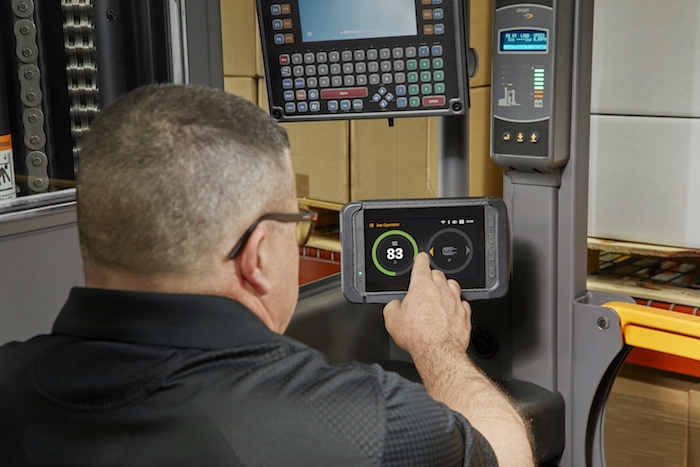
Forklift connectivity promotes safety on the shop floor
September 23, 2019
By Kim Stachler
 Photo: Crown Equipment
Photo: Crown Equipment September 23, 2019 – The Internet of Things (IoT) and Industry 4.0 are bringing a new level of connectivity to supply chain and manufacturing facilities to help companies identify and resolve issues draining productivity and hindering efficiency.
Greater connectivity can be a valuable asset in building and maintaining a strong safety culture that can help sustain a safe working environment.
In a connected facility, individual components work interdependently, connecting and communicating with other components and equipment. They work hand-in-hand with other systems and technologies to deliver measurable business value, such as improving productivity, efficiency and safety.
Sensors, software and computing devices are embedded into these connected components, equipment and systems to enable them to collect, send and receive relevant data that can be used to provide greater understanding of your operations and make strategic decisions.
For instance, consider the forklift – specifically safety in and around the equipment. When properly implemented and used to its fullest potential, greater connectivity can transform your safety program and boost safety initiatives to a whole new level. Think of it as Safety 2.0.
Today, valuable information is readily available via forklift fleet and operator management systems that afford managers the opportunity to create and maintain a culture that champions safety. This connectivity is being used to increase engagement, reinforce training and help change the mindsets and behaviour of operators.
In many instances, safety considerations and initiatives in supply chain and manufacturing environments are actually accelerating the adoption of connected technologies and equipment.
Here are four areas where greater forklift connectivity helps to realize safety benefits.
1. Access control
Greater connectivity brings increased rigour and oversight to your compliance processes. Imagine being able to control access to the forklift to ensure only certified operators use the equipment. You can limit access to operators with the required certification and training and set forklift performance parameters, such as speed limits, based on operator experience, training level or accident history. Electronic inspection checklists can guide operators through the vehicle inspection process, documenting what has been completed and the time it took for completion.
2. Damages and injuries
It can be a little shocking when you objectively analyze the number of forklift impacts in a typical supply chain or warehouse environment. In some facilities, 50 or more impacts a day are common and considered part of the cost of doing business. Unfortunately, that cost can often include damage to the facility, equipment and product. Greater connectivity provides visibility that helps create an accurate picture of how, when and where impacts are occurring. Using the gathered data, you can identify areas of the facility where impacts are occurring and the operators who are involved. You can even receive real-time alerts so the incident can be investigated and addressed.
3. Equipment and maintenance
Expanding connectivity to service and maintenance can reduce downtime and increase visibility into service status, while also enabling you to prepare for potential future capabilities, such as predictive maintenance or hourly-based planned maintenance. It can also help increase safety. With digital checklists, equipment with safety issues can now be more easily identified and locked out. Alerts can be sent to maintenance supervisors letting them know about the issue. Also, given that greater connectivity provides greater understanding of how the trucks are being used, planned maintenance can more accurately be aligned with the business cycle.
4. Operator coaching and training
One area of connectivity where there is growing potential for increasing safety is with technology that creates a more informative and personalized experience for operators. Equipment operation can be tailored to each user and real-time feedback is delivered. Real-time feedback sent to operators reinforces correct behaviour and recognizes incorrect behaviour. This can be in the form of context-sensitive visual and audible alerts delivered through the forklift display module to promote safety awareness. Think of it as a virtual onboard safety coach for each operator. An example of this is an alert that reminds operators to wait until the vehicle comes to a complete stop if they start to exit too soon.
It is important to remember that everyone can be a contributor to safety, and it starts with the right mindset that produces safe behaviours: proper safety training, enforcement, policies and best practices. As facilities implement more connected technology, companies have more tools to help create and maintain a strong safety culture where safety is top of mind.
_____
Kim Stachler is the marketing connected product manager for Crown Equipment.
This article originally appeared in the September 2019 issue of Manufacturing AUTOMATION.
Advertisement
- Weidmuller Canada unveils new warehouse operations at renovated HQ
- GM halts two-thirds of St. Catharines production over strike by U.S. auto workers